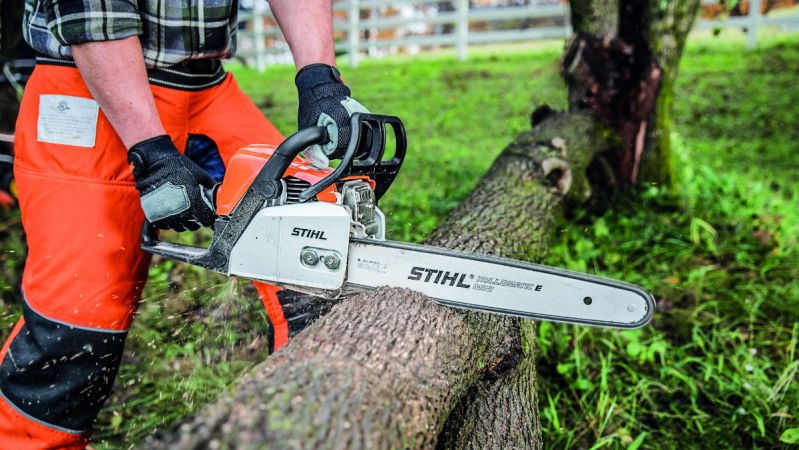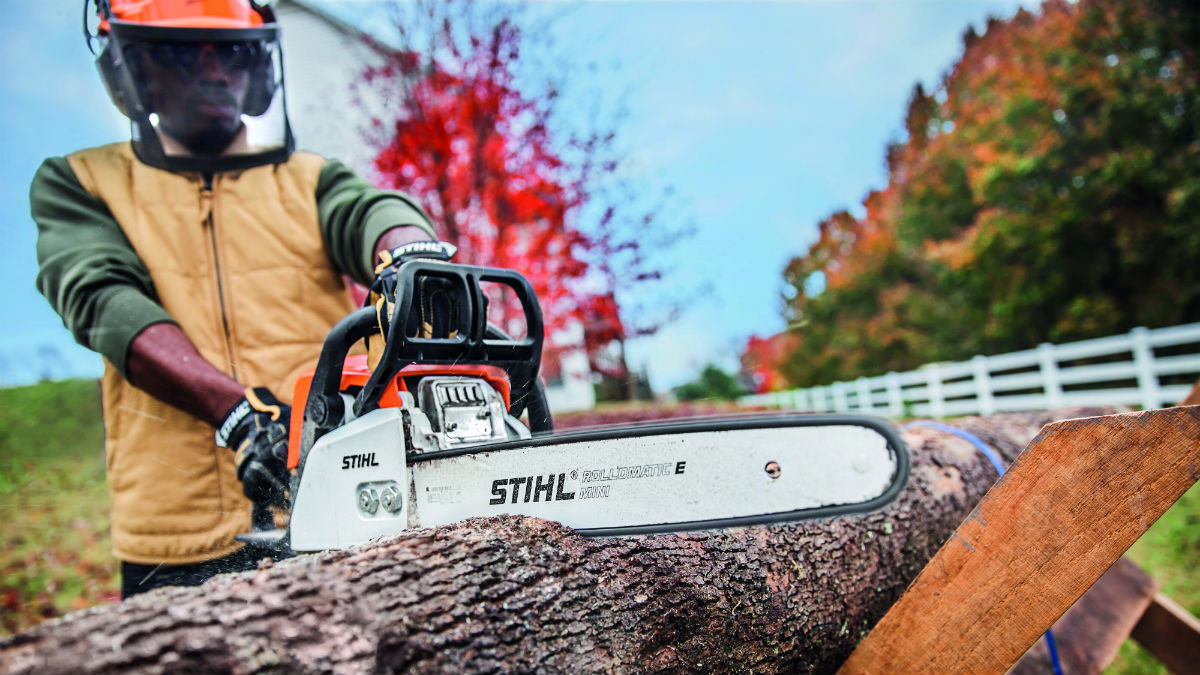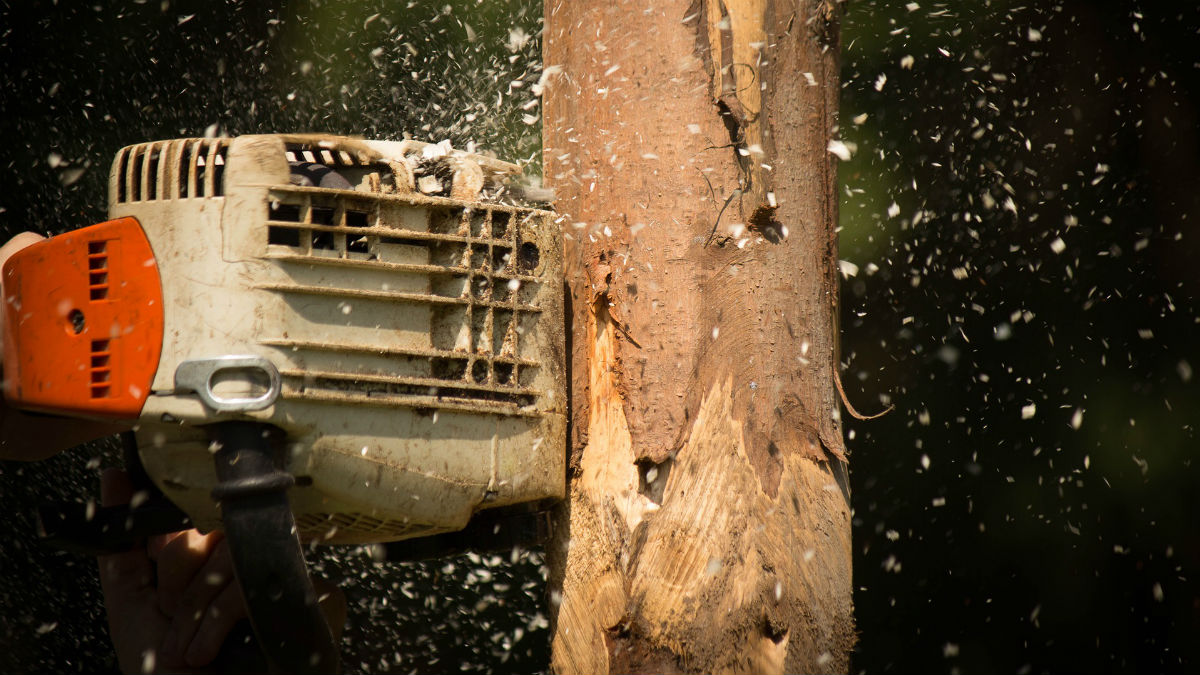
Picture this: You wake up one morning and see the big dogwood tree in your front yard growing ferociously above your driveway and a row of overgrown shrubs lining the house. You think to yourself, “Hey, I’m a handyman. Let’s cut some of those limbs down and clean this place up.”
Why spend money on a tree service when you can get the job done with a chainsaw yourself, right?
For starters, knowing how to operate a chainsaw isn’t your everyday task, but it is a dangerous one. Simply grabbing a chainsaw from Lowe’s and hacking everything in your yard down is going to be much harder than it looks, and you’ll need to be prepared for the task at hand.
There are rules for operating a chainsaw safely and, today, we’re going to give you the rundown, including appropriate equipment, starting methods, and proper chain and gas maintenance. We spoke to STIHL representative Jeff Taylor to gather everything a beginner needs to know when learning how to use a chainsaw.
Safety First
Saftey is priority No. 1. Like any job you do, you need to be properly dressed. STIHL recommends the following gear:
- Hard hat — or you can even take it a step further with a helmet system ($27) that includes a hard hat, face screen, and ear plugs.
- Slip-resistant and cut-protection gloves ($27)
- Eye-protective goggles ($11)
- Cut-retardant or steel toe boots
- Chaps with 6 to 9 layers of cut-retardant material ($60)
(Note: The CDC says there are around 36,000 chainsaw-related injuries annually. So when we say safety first, we mean it.)

Next, you’ll want to survey the area you’ll be working in. Make sure there are no bystanders around and keep clear of telephone lines, cars, or anything else that might get damaged. With that being said, it’s a good idea to have someone else there in case of emergency.
Another rule of thumb for using the chainsaw safely and correctly is to never operate the unit over shoulder height or on a ladder. It’s easy to think you can just climb a ladder and start laying waste on the foliage in the yard. However, if it requires over-the-shoulder utility or you need a ladder to reach certain limbs, STIHL recommends turning to your local tree-hacking specialists. The risk of injury is not worth it.
Prepping the Chainsaw
We’re almost ready to start operating the chainsaw, but first, take a quick inspection of the unit to assure everything is in place, there is nothing missing, and the chain is not loose.
Chainsaws use two-stroke fuel, meaning you’ll need a mix blend (2.6 ounces of oil per 1 gallon of gas) and not just a can of regular gas. You could also opt for a can of Motomix ($30), a premixed ethanol-free fuel blend that has a 2-year-plus shelf life. You also need to make sure you keep your bar oil full so your chain stays lubricated.
A lot of maintenance issues come from leftover fuel in the machine for too long or someone not mixing the oil and fuel properly. You’ll make it easier on yourself in the long run if you just have everything ready to go from the start.
Starting a Chainsaw
Now it’s time to start the unit. Taylor gave us two STIHL-approved methods for starting a chainsaw:
- This first method is recommended for new users. First, place saw on the ground, with a level surface and strong footing. Place your right foot through the rear handle to keep the machine steady. Once you’re ready, take the left hand and reach over to hold the handlebar securely. Then, with your right hand, engage the chain brake to make sure the chain doesn’t move until you’re ready to start cutting. Lastly, pull straight up on the starter.
- The second method is for more experienced users or if you’re on a surface without good footing or if there is lots of underbrush beneath you. First, place the rear handle between your legs, behind the knee area. Then, grab the handlebar with your left hand, with your arm straight out. When you have support on left knee, and the handle is behind your right knee, pull up on the starter.
Be sure to never let the chain touch the ground. This will not only damage and dull the chain, but it can cause unpredictable movements that may cause injury.
Using a Chainsaw
When operating a chainsaw, you always want to stand to the left of the powerhead. Sorry southpaws, but these ‘saws are all designed with the cutting attachment on the right side and they must be used accordingly.
A chainsaw is useful for three tasks: limbing, bucking, and felling.
- Limbing: Removing branches and limbs from a downed tree.
- Bucking: Cutting the trunk of a downed tree to length.
- Felling: Cutting an upright tree in a controlled, safe, and calculated manner.
- 1. Limbing.
- 2. Bucking.
Aside from positioning and good footing, there are a few things that every beginner should be aware of before they start:
- Always know where the bar and chain are, and keep your eyes fixated on them to make sure you see everything you’re cutting.
- When cutting through a log, you’ll want to see where the log starts to pinch so you don’t allow the guide bar to get pinched. If this happens, you can experience what is known as a kickback, or when the guide bar flings back at the operator. The first line of defense against kickback is never to engage the saw with the upper corner of the bar — be aware of the position of the tip at all times. You should also practice good operating techniques, including using a firm, two-handed grip on the saw and keeping a sharp, tensioned chain.
- Some folks have a tendency to cut all the way through a log that is sitting above the ground. Remember: Never let the chain hit the ground.
- Another common mistake is when someone uses the machine like a knife or hand saw. This is not how a chainsaw operates. When bucking, or cutting a tree on the ground, put the guide bar into the cut closest to the powerhead. There is a bumper spike in front of the powerhead that is used as a leverage point so you can let the saw work through the log, rather than you try to saw through it.
- It’s important to recognize that the wood you’re cutting could be under a lot of tension. Watch the fibers of the wood and see how it reacts to your cuts. It’s easy than you might think to accidentally release a limb you didn’t see and experience a reactive force.
- Many first-time users have a tendency to use the tip of the guide bar when limbing. Use the rear of the bar with your bumper spike as much as possible.
- Felling and plunge-cutting techniques should be watched and researched beforehand — or left up to professionals. They’re simply too intricate to tackle after reading a manual
When you’re done, it’s time for a beer.





